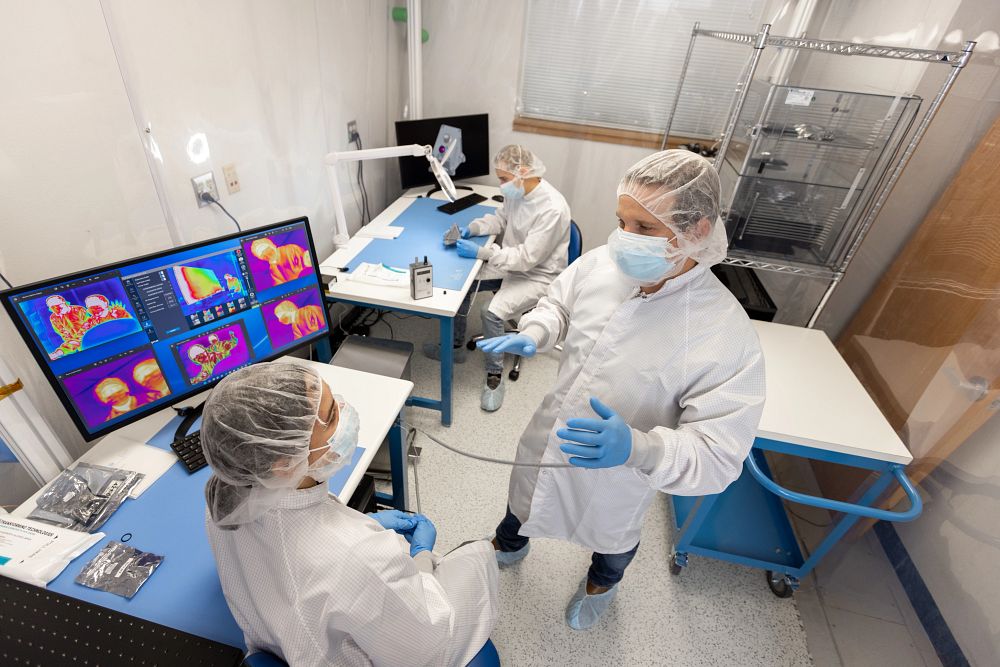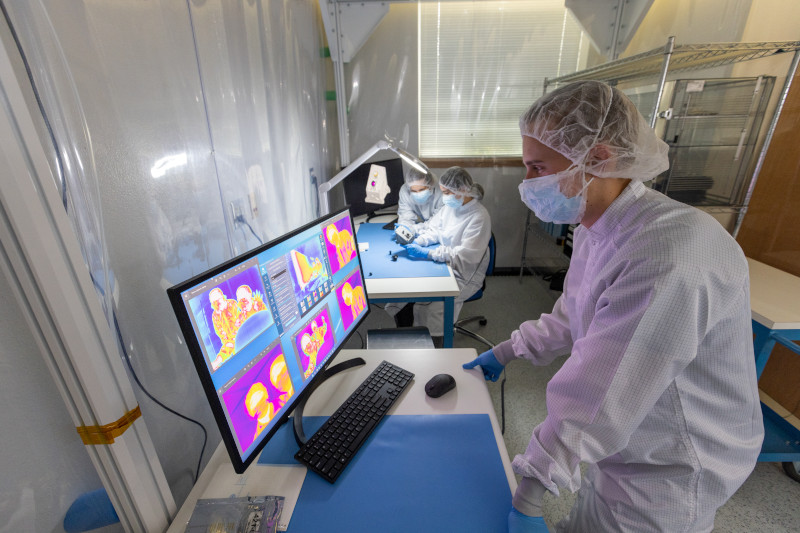Covered in “bunny suits” from head to toe, 27 Northern Arizona University students have been hard at work in a cleanroom designing, fabricating and testing a new dual wavelength camera system. The hardware could one day be part of a new generation of small interplanetary NASA missions such as the upcoming Escape and Plasma Acceleration and Dynamics Explorers (EscaPADE) small-sat mission slated to launch in 2024.
The students are on a multidisciplinary team led by associate professor Christopher Edwards, co-led by professor David Trilling, postdoctoral scholar Chris Haberle and associate professor Michael Shafer.
The project began earlier in 2022 when Robert Lillis of the University of California, Berkeley’s Space Sciences Laboratory, the principal investigator for EscaPADE, discussed with Edwards what a student-led camera might look like for inclusion on a small interplanetary spacecraft mission. NASA commonly collaborates with universities to offer opportunities for student spaceflight hardware projects to be included in high-fidelity planetary science missions. In order to prove the feasibility of this instrument, the team is diligently working to meet NASA’s rigorous requirements for spaceflight hardware.
If they were to be installed on the two EscaPADE satellites, the NAU dual wavelength cameras—dubbed VISIONS (VISible and Infrared ObservatioN System)—would capture three-band RGB (true color) data and surface temperatures on the planet under investigation simultaneously. For inclusion on a mission to Mars, VISIONS is being designed to capture full-disk images (or images of the entire planet at once) multiple times per day.
“These unique datasets would enable us to observe global-regional scale events in a single snapshot, which is often difficult to obtain given the polar orbits of existing spacecraft,” Edwards said.
The students are building the cameras during classes taught by Edwards, Haberle, Shafer and Trilling, with the goal of having fully flight-qualified instruments by March 2023. The project is funded through a grant awarded by the Office of the Vice President for Research’s Research Equipment Acquisition Program (REAP).
Investment sets stage for future spaceflight projects
The primary goal of this project is to educate and train the next generation of scientists and engineers to design, build and operate spaceflight hardware in ways that are consistent with NASA spaceflight requirements and standards—experience graduates don’t usually have when entering the aerospace workforce. For example, some students are working with industry partners, including Lucint Technologies, to develop the interface electronics, while others are designing a structure capable of withstanding launch environments as defined by NASA’s rigorous tests for spaceflight equipment.
This experience will give these students a competitive advantage. “This project offers an exceptional opportunity for students to get hands-on spaceflight instrument development experience,” Edwards said. “They’re being trained in instrument design; systems engineering; integration and testing procedures; calibration and data processing; and science design principles—skills that will help them find future employment in the space industry or related industries. Having this experience could easily open doors for graduate schools and jobs in the aerospace industry and at NASA labs such as the Jet Propulsion Lab.”
Much of NAU’s investment is in the equipment and infrastructure needed to produce spaceflight-quality hardware, including the Class 10,000 cleanroom and electrostatic discharge protection set up in the Wettaw Building.
“Beyond the current project, this investment will enable NAU to become competitive, leveraging its own substantial spaceflight hardware infrastructure in proposing instrument development for future missions and related industry projects,” Trilling said. “Future cohorts of students could have the opportunity to participate in mission operations and real-time planetary science by commanding these dual-wavelength cameras.”
‘Flipping the model’ of spaceflight hardware development 
According to Trilling, camera systems like this one would normally cost NASA $5 million to $7 million to develop. “We’re trying to develop a new, inexpensive small camera system that will be fully tested to work reliably in space,” he said.
“We’re working to flip the model of how spaceflight hardware is developed,” Edwards says, “by using a combination of low-cost, commercially available sensor and optics technology with custom-built interface electronics and structural housings. Within a couple of years, if we meet all the requirements and if we are approved by multiple entities, cameras built and tested by NAU students could be in orbit around Mars.”
As students are designing and building the cameras, they are running them through the review process. The investigators have invited external engineering professionals to review the designs and give the team advice. “The review process is going well, which is encouraging,” Edwards said.
In November, the team will begin the challenging system integration and test phase for the instruments, simulating the harsh launch and space environments. Students will complete required tests for vibration; electromagnetic susceptibility and compatibility; and thermal vacuum. In addition to other tests, these will fully characterize the instrument performance and ready the instruments to be integrated on future missions.
Students explore exciting new roles
“This project has been really exciting, and it’s also fulfilling because I’m part of project management as well as designing and building the camera,” said Laura Lee, who is pursuing her Ph.D. in astronomy and planetary science. “As an undergrad, I had a lot of leadership positions in student organizations but being able to implement my experience on a real scientific project is really fun. Designing this camera has been very interesting—and it’s been a whirlwind. We have a quick turnaround for this, so I’m learning as I go. Hopefully, I’m inspiring other people in the group, taking on a ground support engineering lead role. I’m in the process of deciding where to take my career next.”
Senior Wyatt Watson, a mechanical engineering major, enjoys getting hands-on design experience. Considering he’s interested in a job in aerospace or going to grad school after graduation, this work is invaluable.
“As a mechanical engineer, I’m in charge of the design of the instrument and have control over the design,” he said. “I get to look at every single part that will go into it, and I will eventually be helping to manufacture the device. I’m getting experience I wouldn’t get anywhere else. I’ve learned so much on this project. For anybody who is coming to NAU as an undergraduate, I would tell them to try to get as much experience as you can while you’re still in school.”
Kerry Bennett | University Marketing





